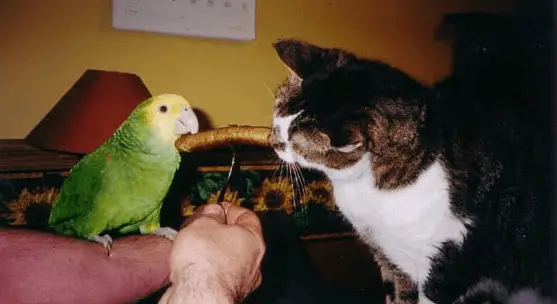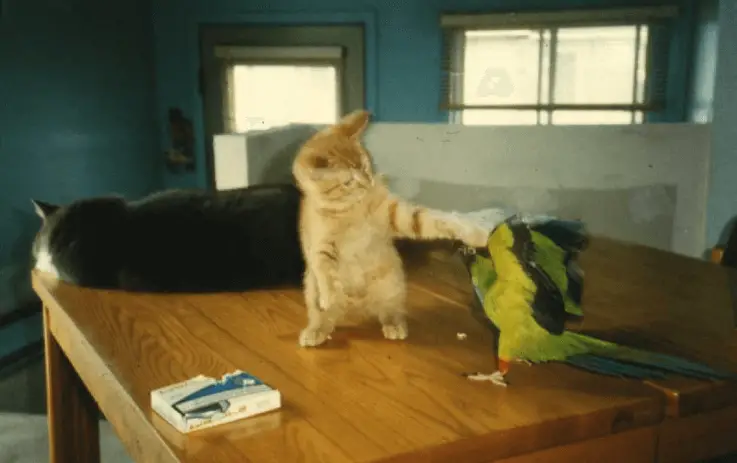
A super fast and precise kick, that’s all Minet had to do to destabilize Ben the senegal parrot. Here he is on the ground, prisoner of his clipped wing feathers. He is at the mercy of this cat who has been waiting patiently for months for this moment of pure pleasure.
Louise is in the shower, so he will have plenty of time to have fun and maybe revel in this terrified little chicken. Suddenly the phone rings. By a curious coincidence, Louise decides to hastily end her shower and answer.
Arriving in the living room, she discovers the scene of the crime… She catches Ben quickly, Twink runs away at a brisk pace and the phone stops ringing. Ben looks correct, but can we really be sure?
Cat Fighting With Parrot
SOURCE:Storyful
There are hundreds of stories of pet bird predation by the cat or dog of the house. They all have one thing in common: the bad bacteria in the mouths and claws are terribly dangerous for the bird.

Even if no injuries are visible from the outside, veterinary intervention is absolutely necessary. Sometimes the sharp twink claws only pierced the parrot’s skin, leaving only a tiny hole invisible to the naked eye. Despite everything, the damage is done. Bacteria have just been deposited in the poor bird.
These bacteria, if not treated in time, will only take 24 to 48 hours to multiply and eventually cause a fatal infection.
Any bird that has had questionable contact with a dog or cat should be treated quickly with antibiotics, and not just any. It is risky to want to treat your parrot yourself with a leftover Baytril prescribed some time ago for another problem.
In some cases, Baytril on its own will not be effective against all of the microorganisms that may be involved in cat and dog bites.
Studies in humans have shown that several bacteria can be transmitted during a bite. They all have pretty names:

- Pasteurella
- Streptococcus
- Staphylococcus
- Neisseria
- Corynebacterium
- Moraxella
- Enterococcus
- Fusobacterium
- Bacteroides
- Porphyromonas
- Prevotella
- Propionibacterium
- Peptostreptococcus
… but are certainly not nice!
Of these microorganisms, three bacteria are more frequently isolated from infected bite wounds: Staphylococcus aureus, Pasteurella multocida and anaerobic cocciae. It is the Pasteurella multocida bacterium that seems to be more to be feared! In the presence of a virulent strain, sepsis (a generalized infection spreading through the blood ) occurs and death occurs rapidly. Less virulent strains have time to colonize the lungs, liver, kidneys, spleen and heart.

The toxins produced by the bacteria damage the blood vessels, causing bleeding that permanently damages these organs. There is evidence that the infection rate is much higher with a cat bite ( up to 80% of cases ) compared to dog bites ( up to 18% of cases ). Although most strains of Pasteurella multocida are sensitive to Baytril, this medicine alone cannot control all of the microorganisms normally identified in the mouths of dogs and cats.

It is for this reason that the administration of a single antibiotic to treat this type of infection still sometimes results in the death of the bird. A few drug combinations are well known to control the majority of pathogens involved in bites: Baytril ( Enrofloxacin ) + Antirobe ( Clindamycin ), Penicillin G + Cefadrops ( Cephalexin ), Antirobe (Clindamycin) + Trimetroprim sulfa.
Prompt care of any bird that has been exposed to a dog or cat by your veterinarian is therefore vital. Some of these antibiotics are only given by injections.
It should also be remembered that a parrot can ingest bad bacteria while grooming itself if its feathers have come in contact with the saliva of a dog or a cat. Close contact ( even without attack ) between these predators and a bird is sufficient to decide, in certain situations, to initiate antibiotic therapy.
In case of injury, clean the wound well with chlorinexidine ( Hibitane ) and go quickly to your veterinarian. The attacked bird may also suffer from fractures, air sac rupture, secondary internal bleeding, and damage to internal organs. The victim is often in great pain, even if nothing appears. She often has difficulty breathing and is already dehydrated and hypothermic when presented to the vet.
Administration of antibiotics alone is therefore not sufficient. The treatment protocol for these birds includes fluids, pain control medication, heat ( incubator) and oxygen if necessary. Sometimes it is also necessary to suture a wound or repair a fracture.
Related Articles:




















